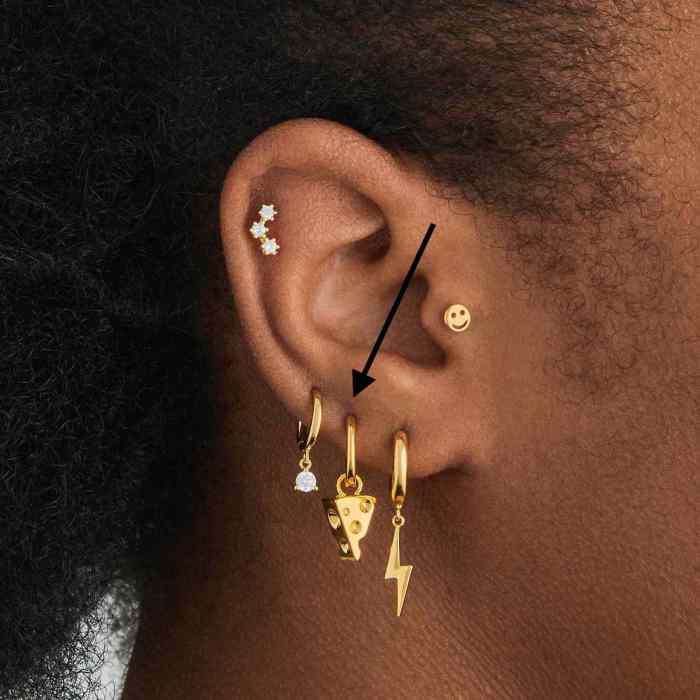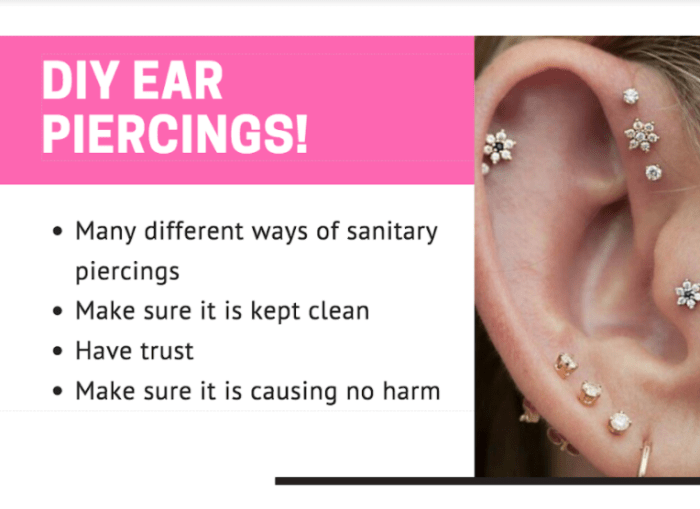DIY ear piercing has gained popularity as individuals seek a more personal and affordable approach to body modification. While it offers a sense of control and convenience, it’s crucial to understand the potential risks and complexities involved. This guide aims to provide a comprehensive overview of the DIY ear piercing process, covering everything from essential supplies to aftercare and safety precautions.
The appeal of DIY ear piercing lies in its perceived affordability and accessibility. Many individuals find it empowering to take control of their body modifications, avoiding the potential discomfort or perceived judgment of a professional piercing studio. However, it’s essential to acknowledge the inherent risks involved, including the possibility of infection, allergic reactions, and improper healing.
The Piercing Process
Performing a DIY ear piercing can be risky and is not recommended. However, if you are determined to proceed, it is crucial to understand the steps involved and prioritize safety throughout the process. This guide provides a detailed step-by-step process for DIY ear piercing, but remember that it is essential to consult with a professional piercer for a safe and hygienic piercing experience.
Marking the Piercing Site
Before piercing, it is vital to mark the desired piercing site accurately. This step ensures that the piercing is placed correctly and avoids any complications.
- Use a permanent marker to draw a small dot on the earlobe where you want the piercing to be.
- Ensure the dot is centered and aligned with your earlobe’s natural curve.
- Double-check the placement by looking in a mirror from different angles.
Sterilizing the Area
Maintaining proper hygiene is paramount during the piercing process. Sterilizing the piercing site and tools reduces the risk of infection.
- Wash your hands thoroughly with soap and water before starting the piercing process.
- Clean the earlobe with rubbing alcohol or a sterile saline solution.
- Allow the area to air dry completely before proceeding.
Using the Piercing Tool
Using a piercing tool requires caution and precision. The tool should be sterilized before use and handled with care.
- Use a sterile piercing needle designed for ear piercing.
- Hold the needle firmly and perpendicular to the marked piercing site.
- Quickly and decisively push the needle through the earlobe, following the marked dot.
- Once the needle is through, gently insert the piercing jewelry into the hole created.
Aftercare and Healing: Diy Ear Piercing

Proper aftercare is crucial for ensuring your DIY ear piercings heal correctly and without complications. This involves keeping the piercings clean, preventing irritation, and recognizing potential issues.
Cleaning and Disinfecting
Cleanliness is paramount for preventing infections. After piercing, it’s important to cleanse the piercings twice daily, using a saline solution or a mild antibacterial soap. Avoid using harsh chemicals, alcohol, or hydrogen peroxide, as these can irritate the piercings and delay healing.
- Saline solution: Mix a cup of warm water with 1/4 teaspoon of non-iodized sea salt. Soak a clean cotton ball in the solution and gently apply it to the piercing, ensuring you clean both the front and back of the piercing.
- Mild antibacterial soap: Use a mild, fragrance-free soap. Wet the piercing area with warm water, gently apply the soap, and then rinse thoroughly with clean water.
Preventing Irritation, Diy ear piercing
It’s important to avoid touching or twisting the piercings unless necessary. This can introduce bacteria and irritate the piercings. Additionally, avoid sleeping on the piercings, as this can cause discomfort and delay healing.
- Avoid touching: Only touch the piercings when cleaning them, and always wash your hands thoroughly with soap and water before doing so.
- Sleep positions: Try to sleep on your back or side, avoiding direct pressure on the piercings. Use a soft pillow and consider using a travel pillow to prevent pressure on the piercings.
- Avoid tight clothing: Loose clothing will help prevent friction and irritation.
Recognizing Complications
While DIY piercings are often successful, complications can occur. It’s essential to be aware of the signs of infection and seek professional help if necessary.
- Signs of infection: Redness, swelling, warmth, pain, pus, or bleeding around the piercing.
- Professional help: If you notice any signs of infection, contact a piercer or doctor immediately.
Legal and Ethical Considerations
DIY ear piercing, while seemingly straightforward, carries legal and ethical considerations that are important to understand. It’s crucial to acknowledge the potential risks involved and the responsibilities that come with performing this procedure on yourself or others.
Liability Issues
It’s important to recognize that performing a piercing on yourself or another person without proper training and licensing can lead to liability issues. This means you could be held responsible for any complications or injuries that arise from the piercing.
- Negligence: If you perform a piercing without proper knowledge and skills, and it results in an infection or other complications, you could be accused of negligence. This can lead to legal action and potential financial penalties.
- Bodily Injury: If the piercing causes harm, such as a scar, permanent damage, or infection, the injured party could sue for damages. This can include medical expenses, lost wages, and pain and suffering.
Personal Stories and Experiences

The world of DIY ear piercing is filled with a diverse range of experiences, from triumphant success stories to cautionary tales of complications. Hearing these firsthand accounts can provide valuable insights into the emotional and practical aspects of piercing at home.
Success Stories
Many individuals have successfully pierced their ears at home, often citing reasons like cost-effectiveness, convenience, or simply a desire for a more personal experience.
- Some individuals have found that DIY ear piercing allows them to control the placement and angle of their piercings, achieving a desired aesthetic that might not be possible with a professional piercer.
- Others have reported a sense of empowerment and accomplishment from successfully piercing their ears themselves.
- Some have shared that the process of piercing their ears at home fostered a sense of connection with their bodies and a deeper understanding of their own anatomy.
Complications and Challenges
While many individuals have positive experiences with DIY ear piercing, it’s crucial to acknowledge that complications can arise.
- Some individuals have reported infections, scarring, or uneven piercings as a result of improper technique or hygiene.
- Others have experienced difficulties with healing due to improper aftercare or the use of unsuitable materials.
- Some have found that the emotional toll of a botched piercing can be significant, leading to feelings of disappointment, frustration, and even self-blame.
Insights into the Emotional and Practical Aspects
The decision to pierce one’s ears at home is often driven by a mix of factors, including personal preferences, financial constraints, and a desire for control over the process.
- Many individuals who choose to pierce their ears at home report feeling a sense of agency and empowerment, particularly those who have previously experienced negative experiences with professional piercers.
- However, the emotional impact of DIY ear piercing can vary widely, depending on the individual’s experience and the outcome of the piercing.
- It’s essential to acknowledge that DIY ear piercing can be a risky endeavor, and individuals should carefully weigh the potential risks and benefits before proceeding.
While DIY ear piercing can be tempting for its convenience and affordability, it’s essential to weigh the risks and benefits carefully. If you’re considering piercing your ears at home, thorough research, meticulous preparation, and strict adherence to safety protocols are paramount. However, for complex piercings or those with concerns about potential complications, consulting a professional piercer is always the safest option.
DIY ear piercing can be a fun and affordable way to express your personal style. However, it’s important to prioritize safety and hygiene. If you’re looking for another creative DIY project, you might enjoy exploring DIY mantel ideas to give your home a personalized touch. Once you’ve mastered those, you can even try your hand at designing your own jewelry for your newly pierced ears!
